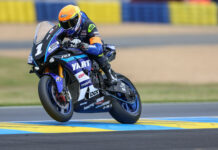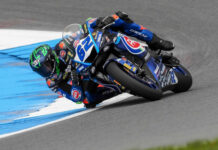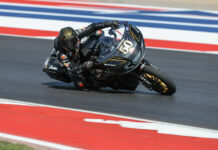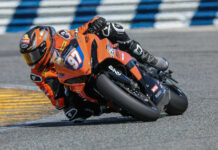Copyright 2004, Roadracing World Publishing, Inc.
FIRST PERSON/OPINION
Via e-mail:
Normally I just read new reports like this and laugh at the obvious errors made by those reporting. But in this instance, I felt compelled to respond. There are possibly a number of errors at work here simultaneously, but without more detailed information regarding the altitude the plane (which may or may not have the curvature of the earth as a factor depending on how high the plane was), the speed of travel, direction of travel relative to the motorcycle, and angle of attack of the plane (whether the plane was level, descending, ascending, or banked into a turn), my comments can only be viewed as information that can put a “reasonable doubt” into the minds of any person who claims to actually use their brain. It is obvious that the “Airborne State Troopers” don’t fall into this category, or don’t understand motorcycles and physics very well. This preamble leads us to a well known phenomena, called Parallax.
First some basic math. 60 mph = 88ft/sec. At this rate of speed (notice I didn’t say acceleration) the 1/4 mile is traveled in 15 seconds. The one correct part of this whole thing is that, Yes….1/4 mile in 4.39 seconds does = 205 mph. But an approximate half second difference (1/4 mile in 5 seconds instead of 4.39 seconds) would drop that speed to 180 mph. A 1 second error (1/4 mile in 5.39 seconds) drops that speed to 168 mph.
168 mph is a completely believable speed for a stock CBR1000RR, as is 180 mph for a moderately to highly tuned 1000cc street legal sportbike.
Is it possible to introduce a half second or 1 second human error into this equation? YES, especially when Parallax is considered. The definition of Parallax is provided below.
Source: The American Heritage® Stedman’s Medical Dictionary, Copyright © 2002, 2001, 1995 by Houghton Mifflin Company. Published by Houghton Mifflin Company.
Main Entry: par·al·lax
Pronunciation: ‘par-&-“laks
Function: noun
: the apparent displacement or the difference in apparent direction of an object as seen from two different points not on a straight line with the object
From this definition, it becomes apparent that a large number of factors can introduce optical illusion errors. Since the original article states that the motorcycle was accelerating away at an apparent rate of twice the speed of the plane, and the plane is viewing the entire event from above and behind, there is very little chance the measurement made from hundreds of feet in the air is anywhere near accurate. The spotter would be “ASSUMING” when the front tire did in fact cross the line that he used to start the watch, AND worse yet as the bike accelerates (not speeds) away and increases the distance between the plane and the motorcycle, the timing when the front wheel crosses the second line used to stop the stop watch is even MORE OF AN ASSUMPTION.
Then we have to ask, was the bike going uphill or downhill at all? Because if it was doing either, depending on what height the plane was, the motorcycle may have looked like it crossed the line sooner from a viewing position above and behind. Or if the plane was traveling at any direction other than perpendicular to the direction of travel of the motorcycle, that would also affect the person’s ability to accurately judge the time the motorcycle crossed the white line.
The officer also said he was “ready.” Well, how ready was he? Did he maybe time the rear wheel as it crossed the first line and then the front wheel as it crossed the second line? All these issues add a significant degree of error due to the extremely short time duration over which the entire event occurred.
This also explains why the “photo-finish” cameras are placed perpendicular to the direction of travel of the “racing objects” as they cross the finish line in ALL FORMS OF RACING. Or, more simply, the photo finish camera is taking a picture that is parallel to the finish line, as things move across the finish line. You never see the photo finish cameras above and behind the finish line. Add in the height of plane and consider if the plane was high enough the curvature of the earth must also be factored into the equation, and you can see why this claim is just a publicity vehicle for that police department.
I could get into the physics required to push a motorcycle that fast against air, or that the really basic error is that NO VEHICLE, be it two wheels or four wheels, that is street legal in any way, shape or form can accelerate to 205 mph in 4.39 seconds regardless of how fast they were going to start with because of the wind resistance at those speeds, but I won’t. So the question becomes, why didn’t the police stop the bikes earlier when they saw them racing along an interstate with other traffic?
Any lawyer with a basic college understanding of physics and motorcycles would be able to get this case reduced or thrown out.
Reginald J. Gaudino, Ph.D.
Gaudino & Associates, Inc.
Oceanside, California
Dr. Gaudino is a licensed road racer…Editor.
Dr. Gaudino Weighs In On Parralax, Physics And The Infamous 205-mph Speeding Bust In Minnesota
Dr. Gaudino Weighs In On Parralax, Physics And The Infamous 205-mph Speeding Bust In Minnesota
© 2004, Roadracing World Publishing, Inc.






